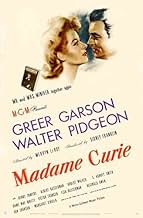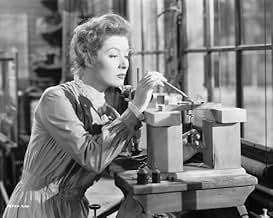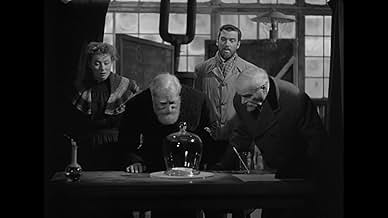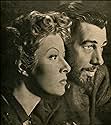Füge eine Handlung in deiner Sprache hinzuDespite himself, accomplished physicist and avowed bachelor Pierre Curie falls for brilliant student Marie, and together they embark on the discovery of radium.Despite himself, accomplished physicist and avowed bachelor Pierre Curie falls for brilliant student Marie, and together they embark on the discovery of radium.Despite himself, accomplished physicist and avowed bachelor Pierre Curie falls for brilliant student Marie, and together they embark on the discovery of radium.
- Für 7 Oscars nominiert
- 3 Gewinne & 7 Nominierungen insgesamt
- Madame Eugene Curie
- (as Dame May Whitty)
- Narration Spoken By
- (Synchronisation)
- Tall Woman
- (Nicht genannt)
- Man at Accident
- (Nicht genannt)
- Swedish Queen
- (Nicht genannt)
- Lecturer
- (Synchronisation)
- (Nicht genannt)
- Professor
- (Nicht genannt)
Empfohlene Bewertungen
In the late nineteenth century, a beautiful young Polish woman enrols at the Sorbonne. Mademoiselle Sklodowska is a brilliant physicist, and before long she has been attached to Doctor Curie, the shy boffin with the large laboratory. One day, the lives of both scientists are profoundly affected when a colleague shows them the strange radiant properties of certain rocks. Marie and Pierre decide to devote their careers to understanding how minerals can cause changes in a photographic plate.
Mervyn LeRoy ("I Am A Fugitive", "Gold Diggers", etc) directed this conservative little biopic with quiet professionalism. If the film never truly hits the heights, it has to be said that it is a near flawless piece of workmanship. The writers, Osborne and Rameau, produced a literate and well-paced screenplay, and the incipient romance between the two shy scientists is depicted with delicacy and gentle humour.
Doctor Curie gradually falls for his gifted student. The graduation ceremony is cleverly depicted as a crowded sell-out, which the absent-minded doctor almost misses. We hear, but do not see, Marie receive the first prize.
The critical point in the relationship comes when Pierre invites Marie to spend a weekend at his parents' country villa. Marie retires to bed, and the agitated Pierre spends the night pacing up and down in his room, not entirely sure what is bothering him. When he finally resolves to propose marriage, we see him ascend the stairs walking away from the camera: this emphasises his nervousness, because he is moving 'out there'. After Marie accepts, Pierre is shot from the reverse angle going back down the stairs - now he 'belongs' to Marie, and we see him from her point of view. The scenes which follow are deeply attractive. The studio sets of the villa garden and Grenoble are sumptuous, and the location shots of the honeymoon absolutely idyllic. The hard labour back in Paris will seem all the grimmer after this interlude.
The film is almost an hour old before Marie embarks on her discovery of radium. The experiment to separate uranium and thorium is lit from below, resembling the dramatic paintings of Joseph Wright of Derby. Infinite patience was required during the four years of toil which culminated in the preparation of radium, and the film conveys a vivid sense of the Curies' dedication. The new century begins with the gentle glow of the isolated radium sample, a beacon heralding the wonders of the dawning age.
Interesting side issues include the appearance of a very young Robert Walker as David, the lab assistant, and an equally callow Van Johnson as the cub reporter. Some lines in the script were perfectly innocent in their day, but raise a titter now. Telling Marie how much she will like his father, Pierre goes on to add, "And my mother's quite gay - you'll enjoy them both!" When Pierre leaves the house in pouring rain on some purpose of his own, Marie calls after him, "Don't forget your rubbers!"
Marie's reaction to the news of the accident is well done, but her final speech to the Faculty of Science fails to inspire. It is her work that is uplifting, not her oratory, and the film puts this across.
Verdict - Solid, well-made biopic which doesn't quite ignite.
On the whole, 'Madame Curie' was very well done, infinitely superior to the recent 'Radioactive' that had a great lead performance but was mostly very disappointing. It is not easy making an interesting and accessible film of this subject, which absolutely fascinated me but may be too complex and dry for others less familiar with Curie and her contribution to science, but 'Madame Curie' does so admirably if imperfectly. Although it is not perfect, there is a lot to admire.
Will start with what 'Madame Curie' does well. It is impeccably made and produced, with sumptuous sets and costumes complemented beautifully by even more elegant and suitably glossy cinematography. The music doesn't get too melodramatic or over-scored, while still excelling in bringing out the story's emotional core without overdoing it. LeRoy directs sympathetically while still being involved, seldom feeling leaden. The script is intelligent and well meaning, if occasionally rambling.
The story is more respectful to the truth than expected, given the general reputation of biopics straying from the facts. Not only is the personal life element emotionally investable and not soapy, everything with Curie's findings more accessible than expected also. One wasn't too favoured over the other, the characters aren't too sketchy (Curie and Pierre are both interesting) and the film does a far better job than 'Radioactive' at how progressive her findings were, their influence in science and how her mind worked. As well as the extent of the adversity that she faced. The first third is especially entertainingly and sensitively done and the more serious middle act is more serious yet fascinating.
Greer Garson may not look like Curie but her performance is still sincere, forceful and deeply committed. She is great at making Curie an interesting character and a real person rather than an icon or caricature, with so much to admire yet with flaws. Walter Pidgeon is a reliably strong presence, superb in his delivery of the speech to the jeweller, and their chemistry is magic. The rest of the acting shows fine talent giving their all.
It's not perfect, with some very sluggish pacing in the final third. Which also felt too thin, predictable and like the film had run out of steam. Pidgeon is the best thing about this section of the film.
Concluding, very well done and interesting. 8/10.
Based upon Eve Curies book, this film follows along pretty factually the Marie Curie story leading to the couples isolating of Radium in their lab after 4 years of work. The film concentrates on the relationship that forms between Pierre & Marie & the science. The script actually allows for a nice balance there.
Greer Garson is great as Madame Marie Currie. I can't see many other actresses doing as was as she does in this role. Walter Pidgeon is excellent as Pierre & it is these 2 leads that make the film a good one. There is some quick supporting work from Van Johnson but nothing about his cameo really does a lot for this particular film.
This film does show the MGM studio quality as it existed in the 1940's as it goes over very well & is well produced. MGM came into World War 2 as the premiere studio & this film was a strong entry in the biographical film category. It is very obvious that even though the film is set in France near Paris, that Paris was not available for location filming due to the war.
This is a very good film for it's era, being factually based & really painting a positive portrait of who Marie & Pierre Curie were & why they were important in the history of science. It does give short shrift to the couples kids but at over 2 hours the film has too much to cover to do otherwise.
Wusstest du schon
- WissenswertesOnly one scene in the entire film--a long shot of the Curies on honeymoon--was actually filmed outside of the studio, and even that was second unit.
- PatzerWhen Marie determines chemical composition of pitchblende, 7 minerals add to 99%, one mineral (magnesium oxide) is .99% and the "extraneous matter" of .001% all adds up to 99.991%. Presumably the mag-Ox should be .999%, otherwise, the actual extraneous matter would be 10 times greater (.01%) than Marie's stated measurement.
- Zitate
[last lines]
[Madame Curie addresses a large gathering of scientists]
Marie Curie: Even now, after twenty-five years of intensive research, we feel there is a great deal still to be done. We have made many discoveries. Pierre Curie and the suggestions we have found in his notes, and his thoughts he expressed to me have helped to guide us to them. But no one of us can do much. Yet, each of us, perhaps, can catch some gleam of knowledge which, modest and insufficient of itself, may add to man's dream of truth. It is by these small candles in our darkness that we see before us, little by little, the dim outline of that great plan that shapes the universe. And I am among those who think that for this reason, science has great beauty and, with its great spiritual strength, will in time cleanse this world of its evils, its ignorance, its poverty, diseases, wars, and heartaches. Look for the clear light of truth. Look for unknown, new roads. Even when man's sight is keener far than now, divine wonder will never fail him. Every age has its own dreams. Leave, then, the dreams of yesterday. Youth, take the torch of knowledge and build the palace of the future.
- VerbindungenFeatured in AFI's 100 Years... 100 Cheers: America's Most Inspiring Movies (2006)
- SoundtracksTwinkle, Twinkle, Little Star
(uncredited)
from the French melody "Ah ! vous dirai-je, Maman" (music first published 1761)
Played on piano by Linda Lee Gates and Marie Louise Gates
Top-Auswahl
- How long is Madame Curie?Powered by Alexa
Details
- Erscheinungsdatum
- Herkunftsland
- Sprache
- Auch bekannt als
- Madam Curie
- Drehorte
- Produktionsfirma
- Weitere beteiligte Unternehmen bei IMDbPro anzeigen
- Laufzeit2 Stunden 4 Minuten
- Farbe
- Seitenverhältnis
- 1.37 : 1
Zu dieser Seite beitragen



































